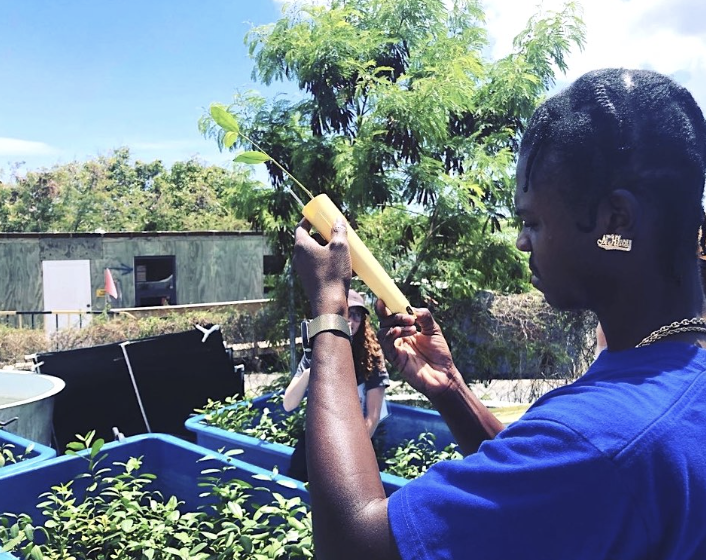Growing Mangroves and Growing Knowledge - Part 1
A U.S. Virgin Islands and British Virgins Island Learning Exchange (Read part 2)
A guest post by Allison Holevoet, Allie Durdall and Dr. Kristin Grimes
Learning experiences are often assumed to be unidirectional, or one-way transfers of knowledge from point A to point B. A “source” provides information, the “learner” takes it in, and that is that. But the reality is that the act of learning can flow between sources and learners, resulting in a learning exchange.
On April 22, 2022 GRROE USVI Mangroves from the University of the Virgin Islands (UVI) Center for Marine & Environmental Studies, hosted an in-person mangrove restoration learning exchange with individuals from the H. Lavity Stoutt Community College (HLCC), Tortola, British Virgin Islands (BVI). The two first met in January of 2021 when the UVI group virtually toured one of the BVI nurseries. Funded by the Community Foundation of the Virgin Islands’ Judith A. Towle Fund, the in-person exchange was the first of two that brought researchers and students together from the the U.S. Virgin Islands (USVI) and the BVI to learn from each other in regards to mangrove restoration.
H. Lavity Stoutt Community College student Shile David examining a black mangrove seedling. Photo: Allison Holevoet
The groups examine and celebrate all of the red mangrove growth at the VIMAS planting site Range Cay, USVI. Photo: Kristin Wilson Grimes
Faculty, staff, and graduate and undergraduate students attended the exchange which began with a tour of UVI’s new Environmental Analysis Laboratory from Amber Packard. Afterwards both groups enjoyed lunch, while exchanging mangrove nursery techniques. Following lunch, the BVI group was all ears as the UVI team explained their nursery maintenance strategies, showcased their plants, and highlighted the planting success of red mangroves at Range Cay by the Virgin Islands Marine Advisory Service (VIMAS) and GRROE USVI Mangroves. The nursery tour was extended to include UVI’s coral nursery and Virgin Island’s Reef Response crew, Dan Mele and Jason Quetel, talked about their coral restoration work with Dr. Marilyn Brandt’s lab. To top off the day and to put the nursery work into a larger, restoration perspective, the exchange ended with a driving tour of St. Thomas’s Bovoni Landfill which sits adjacent to St. Thomas East End Reserve (STEER) mangrove habitat, a marine protected area and potential future mangrove restoration site.
UVI coral aquarist Dan Mele showing the BVI team the coral nursery on UVI’s campus. Photo: Allison Holevoet
Both nursery groups examine red mangroves in the water tables. Photo: Allison Holevoet
UVI nursery intern Tara Thompson explains the thoughts and strategies behind the container experiment for the red mangroves pictured above. Photo: Kristin Wilson Grimes
BVI nursery technician N’Koy Stoutt examines a black mangrove seedling at the UVI nursery.
The exchange was led by UVI associate professor, Dr. Kristin Wilson Grimes, UVI Watershed and Marine Specialist, Allie Durdall, and Head of Marine & Maritime Studies at the Centre for Applied Marine Studies (CAMS) at the HLCC, Susan Zaluski. Grimes leads a group dedicated to growing restoration, research, outreach, and education of the territory's mangroves (GRROE U.S. Virgin Island Mangroves). At the time of the tour, the nursery had grown ~5,000 mangroves (~1,100 red mangroves, ~3,400 white mangroves, and ~500 black mangroves). Propagules have been collected from multiple sites across all three islands in the territory (St. John, St. Croix, and St. Thomas), as well as multiple forest types (salt ponds, fringe mangroves and basin forests). To assess where mangrove restoration is feasible and needed, the team has also established long-term monitoring plots across all three islands. All of these activities provide opportunities for graduate and undergraduate students to learn more about mangrove restoration through participation in field work, nursery maintenance, and near-peer mentoring. In the BVI, Susan Zaluski and students grow mangroves at three nurseries on Jost Van Dyke, Tortola, and Anegada.
“Growing this collaboration and engaging communities across the Caribbean, makes restoration more efficient, effective, and fun, by sharing our successes and learning through failures.”
The BVI team has already begun planting their mangroves at designated restoration sites and engaging community participation to do so. By sharing their experiences and perspectives, the BVI has provided helpful insight into what has and hasn’t worked in a nursery setting and in the field. So, what is next for this exchange? The UVI team plans to visit the BVI nursery early next year. Growing this collaboration and engaging communities across the Caribbean can provide communities and stakeholders with efficient and effective restoration techniques while reducing time, money, and effort on unsuccessful practices in future nurseries and restoration projects.
UVI Master’s of Marine & Environmental Science student, Kayla Halliday, commented, “The BVI learning exchange was such a refreshing way to learn about all of the great things they’ve been doing in their nursery and it was a nice opportunity to network and exchange information. I’m excited to visit their nursery in-person, soon!”
Visit our page to learn more about mangrove research in the USVI, and follow the GRROE team on instagram.
To learn more about the BVI mangrove nursery or the Centre for Applied Marine Studies, please contact Susan Zaluski via telephone at (284) 852-7166 or via email at szaluski@hlscc.edu.vg
This work was made possible by the following partners:







